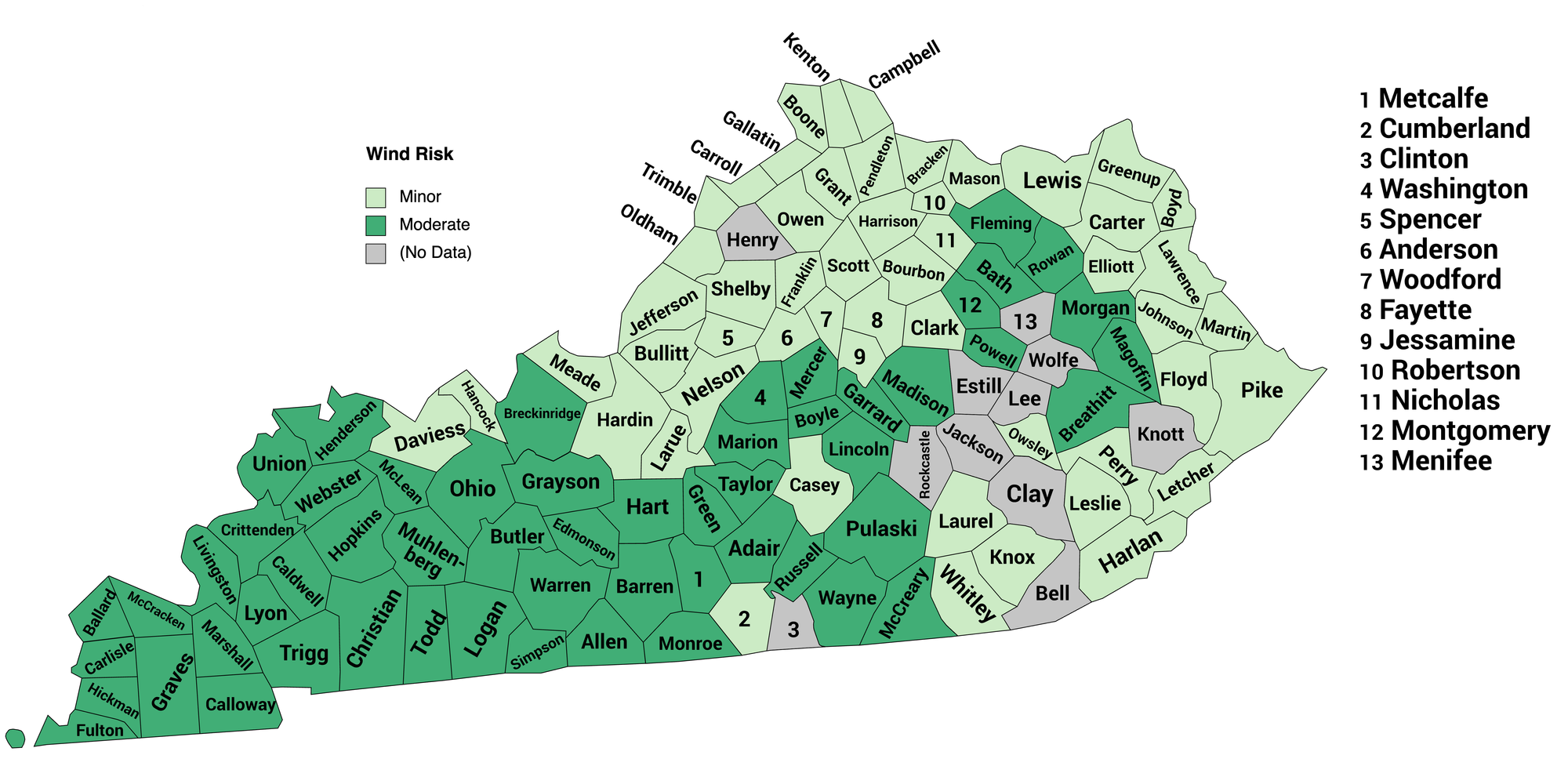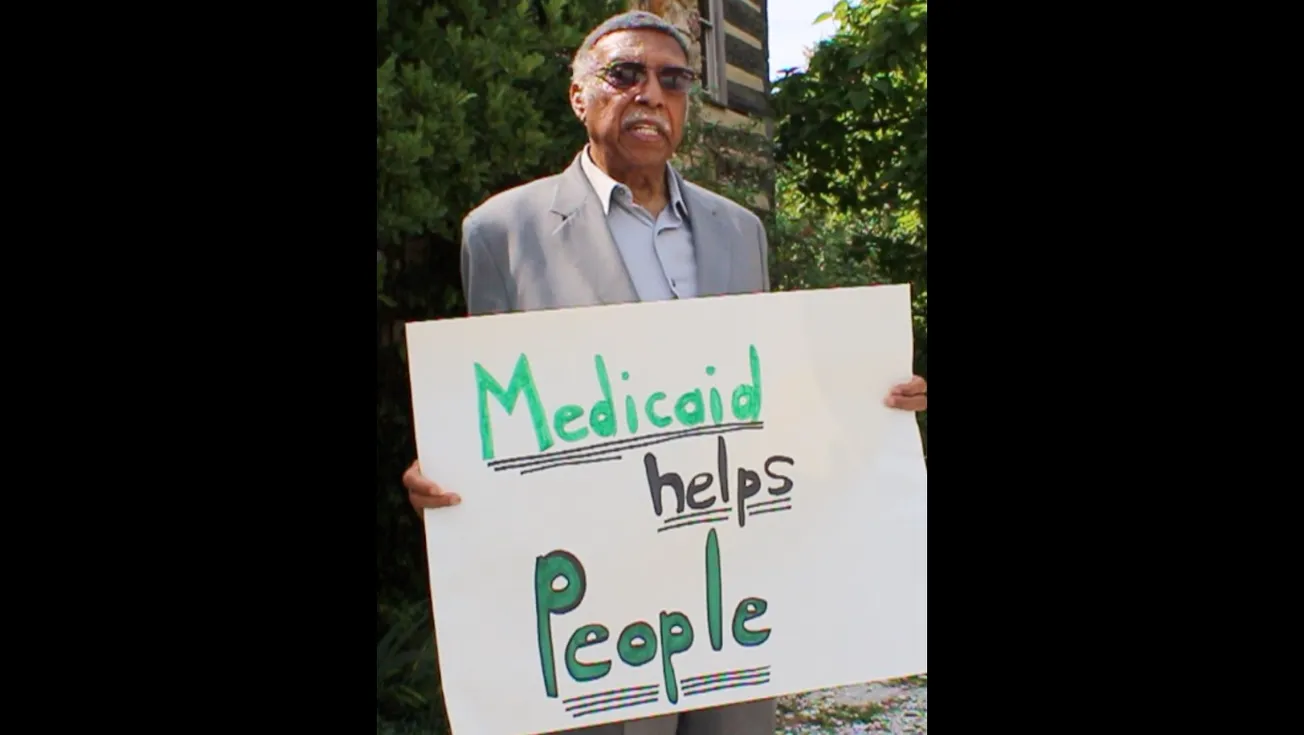The third article in the climate risk series
When looking at the climate crisis, it is rare to get good news. But when it comes to the risk of wind damage in our state, we get some of that rare good news.
According to the Wind Risk Model from the First Street Foundation, all the counties in Kentucky are at either a Minor level of risk from wind, or at a Moderate level. Most of the ones at the Moderate level are in the central and western parts of the state.
From the First Street site: “The First Street Foundation Wind Model considers a location’s current and future risk specifically from hurricane winds. To build an understanding of this risk, tens of thousands of synthetic, computer modeled hurricane tracks are used to build estimates of likely wind speed under the influence of a changing climate. For every location, the likely exposure to extreme wind is calculated for today and 30 years into the future, and takes into account the local conditions such as the roughness of the landscape surrounding a property. The First Street Foundation Wind Model is a geospatially-varying wind model, which means it considers how a location’s likely exposure to high speed winds is affected by climate change’s impacts.”
Map of Wind Risk across Kentucky
Here is the map of the data from First Street:

Wind Risk Data Table
And here is the underlying data. You can sort the table by clicking on a column header.
| County | Wind Risk |
|---|---|
| Anderson | 1 |
| Boone | 1 |
| Bourbon | 1 |
| Boyd | 1 |
| Bracken | 1 |
| Bullitt | 1 |
| Campbell | 1 |
| Carroll | 1 |
| Carter | 1 |
| Casey | 1 |
| Clark | 1 |
| Cumberland | 1 |
| Daviess | 1 |
| Elliott | 1 |
| Fayette | 1 |
| Floyd | 1 |
| Franklin | 1 |
| Gallatin | 1 |
| Grant | 1 |
| Greenup | 1 |
| Hancock | 1 |
| Hardin | 1 |
| Harlan | 1 |
| Harrison | 1 |
| Jefferson | 1 |
| Jessamine | 1 |
| Johnson | 1 |
| Kenton | 1 |
| Knox | 1 |
| Larue | 1 |
| Laurel | 1 |
| Lawrence | 1 |
| Leslie | 1 |
| Letcher | 1 |
| Lewis | 1 |
| Martin | 1 |
| Mason | 1 |
| Meade | 1 |
| Nelson | 1 |
| Nicholas | 1 |
| Oldham | 1 |
| Owen | 1 |
| Owsley | 1 |
| Pendleton | 1 |
| Perry | 1 |
| Pike | 1 |
| Robertson | 1 |
| Scott | 1 |
| Shelby | 1 |
| Spencer | 1 |
| Trimble | 1 |
| Whitley | 1 |
| Woodford | 1 |
| Adair | 2 |
| Allen | 2 |
| Ballard | 2 |
| Barren | 2 |
| Bath | 2 |
| Boyle | 2 |
| Breathitt | 2 |
| Breckinridge | 2 |
| Butler | 2 |
| Caldwell | 2 |
| Calloway | 2 |
| Carlisle | 2 |
| Christian | 2 |
| Crittenden | 2 |
| Edmonson | 2 |
| Fleming | 2 |
| Fulton | 2 |
| Garrard | 2 |
| Graves | 2 |
| Grayson | 2 |
| Green | 2 |
| Hart | 2 |
| Henderson | 2 |
| Hickman | 2 |
| Hopkins | 2 |
| Lincoln | 2 |
| Livingston | 2 |
| Logan | 2 |
| Lyon | 2 |
| Madison | 2 |
| Magoffin | 2 |
| Marion | 2 |
| Marshall | 2 |
| McCracken | 2 |
| McCreary | 2 |
| McLean | 2 |
| Mercer | 2 |
| Metcalfe | 2 |
| Monroe | 2 |
| Montgomery | 2 |
| Morgan | 2 |
| Muhlenberg | 2 |
| Ohio | 2 |
| Powell | 2 |
| Pulaski | 2 |
| Rowan | 2 |
| Russell | 2 |
| Simpson | 2 |
| Taylor | 2 |
| Todd | 2 |
| Trigg | 2 |
| Union | 2 |
| Warren | 2 |
| Washington | 2 |
| Wayne | 2 |
| Webster | 2 |
| Bell | |
| Clay | |
| Clinton | |
| Estill | |
| Henry | |
| Jackson | |
| Knott | |
| Lee | |
| Menifee | |
| Rockcastle | |
| Wolfe |
Notes and Conclusions
Fortunately, our state is pretty distant from the coasts, so hurricanes are not going to be much of a factor in our climate risk.
However, the model doesn’t address tornado risk, which our state has had recent and dramatic experience with. While most experts agree that climate change will cause more tornadoes in the future, predicting them for a given location is still problematic.
If I were an elected official, I might consider if changes are needed to building codes due to tornadoes. But, that wouldn’t do anything about existing structures.
--30--








